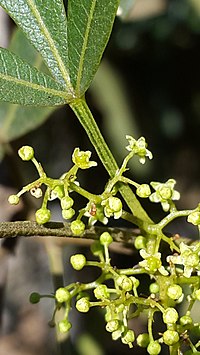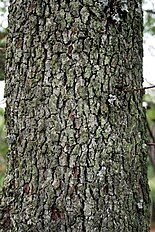Searsia lancea
| Searsia lancea | |
|---|---|

| |
| Foliage detail | |
| Scientific classification | |
| Kingdom: | Plantae |
| Clade: | Tracheophytes |
| Clade: | Angiosperms |
| Clade: | Eudicots |
| Clade: | Rosids |
| Order: | Sapindales |
| Family: | Anacardiaceae |
| Genus: | Searsia |
| Species: | S. lancea
|
| Binomial name | |
| Searsia lancea | |
| Synonyms[1] | |
| |

Searsia lancea commonly known as karee, karree (Afrikaans), is an evergreen, frost hardy, drought resistant tree, which can reach up to 8 metres in height with a 5 metre spread. In North America, where it is naturalized, it is known as African sumac and willow rhus.[2] It is one of the most common trees on the Highveld and in the Bushveld in South Africa, but not found in the Lowveld.
Description and uses

The tree has a graceful, weeping form and dark, fissured bark that contrasts well with its long, thinnish, hairless, dark-green, trifoliate leaves with smooth margins. It bears small yellow flowers followed on female trees by bunches of small yellow-green flattish fruits, which are relished by birds. In earlier times the fruits were pounded, water added and left to ferment, producing an evidently refreshing beer. The tree is a good shade tree for gardens, parks and pavements. It favours areas rich in lime in the Karoo and Namibia.
References
- ^ The Plant List: A Working List of All Plant Species, retrieved 28 April 2016
- ^ USDA, NRCS (n.d.). "Rhus lancea". The PLANTS Database (plants.usda.gov). Greensboro, North Carolina: National Plant Data Team. Retrieved 21 October 2015.
- "Searsia lancea". PlantZAfrica.com. Retrieved 2010-01-28.
- Van Wyk, Braam; Van Wyk, Piet (1997). Field Guide to Trees of Southern Africa. Struik. ISBN 978-1-86825-922-9.


